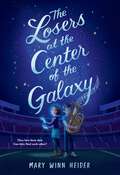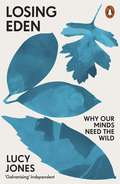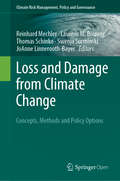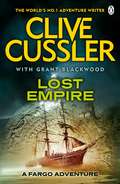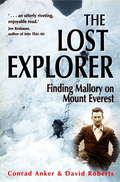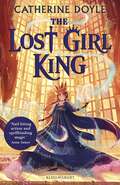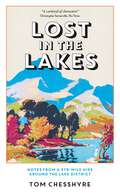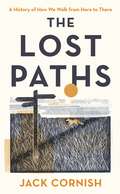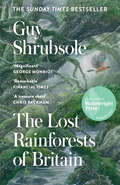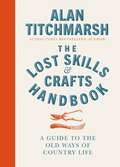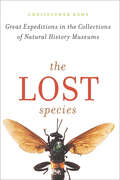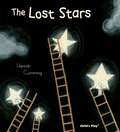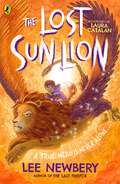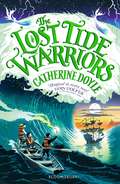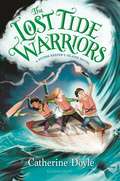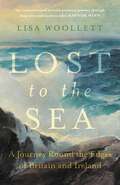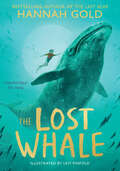- Table View
- List View
The Losers at the Center of the Galaxy
by Mary Winn HeiderA tuba player without a tuba and his jellyfish-imitating sister cope with their father's disappearance in this hilarious and moving novel by the author of The Mortification of Fovea Munson. When Lenny Volpe, former quarterback of the worst professional football team in the nation, leaves his family and disappears, the Chicago Horribles win their first game in a long time. Fans are thrilled. The world seems to go back to normal. Except for the Volpe kids.Winston throws himself into playing the tuba, and Louise starts secret experiments to find a cure for brain injuries, and they're each fine, just fine, coping in their own way. That is, until the investigation of some eccentric teacher behavior and the discovery of a real live bear paraded as the Horribles' new mascot make it clear that things are very much Not Fine. The siblings may just need each other, after all.
Losing Earth: The Decade We Could Have Stopped Climate Change
by Nathaniel RichBy 1979, we knew all that we know now about the science of climate change – what was happening, why it was happening, and how to stop it. Over the next ten years, we had the very real opportunity to stop it. Obviously, we failed.Nathaniel Rich’s groundbreaking account of that failure – and how tantalizingly close we came to signing binding treaties that would have saved us all before the fossil fuels industry and politicians committed to anti-scientific denialism – is already a journalistic blockbuster, a full issue of the New York Times Magazine that has earned favorable comparisons to Rachel Carson’s Silent Spring and John Hersey’s Hiroshima. Rich has become an instant, in-demand expert and speaker. A major movie deal is already in place. It is the story, perhaps, that can shift the conversation.In the book Losing Earth, Rich is able to provide more of the context for what did – and didn’t – happen in the 1980s and, more important, is able to carry the story fully into the present day and wrestle with what those past failures mean for us in 2019. It is not just an agonizing revelation of historical missed opportunities, but a clear-eyed and eloquent assessment of how we got to now, and what we can and must do before it's truly too late.
Losing Eden: Why Our Minds Need the Wild
by Lucy Jones'Beautifully written, movingly told and meticulously researched ... a convincing plea for a wilder, richer world' Isabella Tree, author of Wilding'By the time I'd read the first chapter, I'd resolved to take my son into the woods every afternoon over winter. By the time I'd read the sixth, I was wanting to break prisoners out of cells and onto the mossy moors. Losing Eden rigorously and convincingly tells of the value of the natural universe to our human hearts' Amy Liptrot, author of The OutrunToday many of us live indoor lives, disconnected from the natural world as never before. And yet nature remains deeply ingrained in our language, culture and consciousness. For centuries, we have acted on an intuitive sense that we need communion with the wild to feel well. Now, in the moment of our great migration away from the rest of nature, more and more scientific evidence is emerging to confirm its place at the heart of our psychological wellbeing. So what happens, asks acclaimed journalist Lucy Jones, as we lose our bond with the natural world-might we also be losing part of ourselves? Delicately observed and rigorously researched, Losing Eden is an enthralling journey through this new research, exploring how and why connecting with the living world can so drastically affect our health. Travelling from forest schools in East London to the Svalbard Global Seed Vault via primeval woodlands, Californian laboratories and ecotherapists' couches, Jones takes us to the cutting edge of human biology, neuroscience and psychology, and discovers new ways of understanding our increasingly dysfunctional relationship with the earth. Urgent and uplifting, Losing Eden is a rallying cry for a wilder way of life - for finding asylum in the soil and joy in the trees - which might just help us to save the living planet, as well as ourselves.
Loss and Damage from Climate Change: Concepts, Methods and Policy Options (Climate Risk Management, Policy and Governance)
by Reinhard Mechler Laurens M. Bouwer Thomas Schinko Swenja Surminski JoAnne Linnerooth-BayerThis book provides an authoritative insight on the Loss and Damage discourse by highlighting state-of-the-art research and policy linked to this discourse and articulating its multiple concepts, principles and methods. Written by leading researchers and practitioners, it identifies practical and evidence-based policy options to inform the discourse and climate negotiations.With climate-related risks on the rise and impacts being felt around the globe has come the recognition that climate mitigation and adaptation may not be enough to manage the effects from anthropogenic climate change. This recognition led to the creation of the Warsaw International Mechanism on Loss and Damage in 2013, a climate policy mechanism dedicated to dealing with climate-related effects in highly vulnerable countries that face severe constraints and limits to adaptation. Endorsed in 2015 by the Paris Agreement and effectively considered a third pillar of international climate policy, debate and research on Loss and Damage continues to gain enormous traction. Yet, concepts, methods and tools as well as directions for policy and implementation have remained contested and vague.Suitable for researchers, policy-advisors, practitioners and the interested public, the book furthermore:• discusses the political, legal, economic and institutional dimensions of the issue• highlights normative questions central to the discourse• provides a focus on climate risks and climate risk management.• presents salient case studies from around the world.
Lost Empire: FARGO Adventures #2 (Fargo Adventures #2)
by Grant Blackwood Clive CusslerLost Empire is the second phenomenal FARGO Adventure from international bestseller, Clive Cussler. Some treasures are best left buried . . .Scuba diving off the Tanzanian coast, husband-and-wife treasure-hunting team, Sam and Remi Fargo discover a huge ship's bell, covered in cryptic carvings. But as they struggle to first recover the bell and then decode its clues, they find they are not alone in wanting to discover its secrets.When news of the find is publicised, Mexican President Quauhtli Garza is forced to act. He knows that this bell comes from a former Confederate ship that sank off the African coast and he fears that the discovery of a missing piece of a Quetzalcoatl statuette, which was aboard the ship, will undermine his plans for Mexico's future. With Garza determined to stop the Fargos investigation at all costs, the couple are drawn into a deadly conspiracy that connects the 1883 Krakatoa explosion with an attempt to resurrect the fallen Aztec empire ... Clive Cussler, author of the celebrated Dirk Pitt novels Arctic Drift and Crescent Dawn, presents the second in the series following the adventures of treasure hunters Sam and Remi Fargo. Lost Empire is the second of the FARGO Adventures; Spartan Gold is the first. Praise for Clive Cussler: 'Clive Cussler is hard to beat' Daily Mail
The Lost Explorer: Finding Mallory on Mount Everest
by Conrad Anker David RobertsIn 1999, Conrad Anker found the body of George Mallory on Mount Everest, casting an entirely new light on the mystery of the lost explorer.On 8 June 1924, George Leigh Mallory and Andrew 'Sandy' Irvine were last seen climbing towards the summit of Everest. The clouds closed around them and they were lost to history, leaving the world to wonder whether or not they actually reached the summit - some 29 years before Edmund Hillary and Tensing Norgay.On 1 May 1999, Conrad Anker, one of the world's foremost mountaineers, made the momentous discovery - Mallory's body, lying frozen into the scree at 27,000 feet on Everest's north face. Recounting this day, the authors go on to assess the clues provided by the body, its position, and the possibility that Mallory had successfully climbed the Second Step, a 90-foot sheer cliff that is the single hardest obstacle on the north face. A remarkable story of a charming and immensely able man, told by an equally talented modern climber.
The Lost Girl King
by Catherine Doyle'The Lost Girl King echoes Lord of the Rings and Narnia, whilst being original and fresh. It's sure to become a classic of its own' - Aisha Bushby, author of A Pocketful of Stars'A glorious gulp of a summer adventure' - Piers Torday, author of The Lost Wild'Nobody writes peril, wit and wonder as well as Catherine Doyle … a modern Diana Wynne Jones' - Dave Rudden, author of Irish Children's Book of the Year, Knights of the Borrowed Dark**********Amy and Liam Bell have been packed off to stay at Gran's house in the wilds of Connemara for the summer. Out for a walk on the first morning of their holiday, they trace the flight of a hawk to a nearby waterfall – only to watch the bird disappear through it. Intrigued, the children follow and soon realise they've discovered the entrance to Tír na nÓg, the legendary land of eternal youth.But they've been tricked. Almost immediately Liam is captured by a troop of headless horsemen who take him to Tarlock, the ruling sorcerer of Tír na nÓg, who is seeking the bones of a human child for a sinister new spell.Packed with edge-of-your seat adventure, incredible imagination, humour and warmth, The Lost Girl King is the rare kind of story that has you reading long past lights out.
The Lost Girl King
by Catherine Doyle'The Lost Girl King echoes Lord of the Rings and Narnia, whilst being original and fresh. It's sure to become a classic of its own' - Aisha Bushby, author of A Pocketful of Stars'A glorious gulp of a summer adventure' - Piers Torday, author of The Lost Wild'Nobody writes peril, wit and wonder as well as Catherine Doyle … a modern Diana Wynne Jones' - Dave Rudden, author of Irish Children's Book of the Year, Knights of the Borrowed Dark**********Amy and Liam Bell have been packed off to stay at Gran's house in the wilds of Connemara for the summer. Out for a walk on the first morning of their holiday, they trace the flight of a hawk to a nearby waterfall – only to watch the bird disappear through it. Intrigued, the children follow and soon realise they've discovered the entrance to Tír na nÓg, the legendary land of eternal youth.But they've been tricked. Almost immediately Liam is captured by a troop of headless horsemen who take him to Tarlock, the ruling sorcerer of Tír na nÓg, who is seeking the bones of a human child for a sinister new spell.Packed with edge-of-your seat adventure, incredible imagination, humour and warmth, The Lost Girl King is the rare kind of story that has you reading long past lights out.
Lost in the Lakes: Notes from a 379-Mile Hike Around the Lake District
by Tom ChesshyreJoin travel writer Tom Chesshyre for a lakeland adventure like no other. Explore towering mountains, wide-open valleys and magnificent lakes - stopping off at a cosy inn or two along the way - on a 379-mile hike around the Lake DistrictFrom Penrith and back, via Keswick, Cockermouth, Coniston, Grasmere and Windermere, plus many places in between, Tom Chesshyre puts on his walking boots and sets forth in a "big wobbly circle" around the Lakes, drawn onwards by the dramatic scenery that attracts more than 19 million visitors each year.Across landscape that so inspired the Romantic poets, he takes in remote parts of the parkland that many tourists miss - enjoying encounters aplenty with farmers, fell runners and fellow hikers, while staying in shepherds' huts, bothies and old climbers' hotels along the way, and even going for a (chilly) dip in Derwentwater.This is the Lake District seen from its walking paths - with just a backpack, an open mind... and a spring in the step.
The Lost Orchard: A French chef rediscovers a great British food heritage
by Raymond BlancPICKED BY DIANA HENRY AS ONE OF THE TELEGRAPH'S COOKBOOKS OF THE YEAR 2019.'The legendary chef opens the door to a living library of lost varieties of heritage English fruit in a treasury of recipe and reflection.' Waterstones Weekly'Blanc set about the most thorough apple-tasting and cooking project I have heard of . . . [The Lost Orchard] condenses the highlights, his love letters to the forgotten apple breeds.' The Times'I began to dream about an orchard filled with thousands of fruit trees... Today we have an orchard with over 150 ancient varieties of apple. Each one has its heritage in a village or a county that used to thrive on that particular variety. They tell the story not only of what we have lost in Britain but also what we could regain.'Over the past seven years, Raymond Blanc has planted an orchard of 2,500 trees in the grounds of his hotel-restaurant in Oxfordshire. Yielding about 30 tonnes of fruit for his kitchen each year, it is full of ancient and forgotten varieties of British apples and pears, along with walnut trees, quince, medlars, apricots, nectarines, peaches, plums, damsons and cherries. A further 600 heritage fruit trees have been added from Raymond's home region of Franche-Comté in France. The Lost Orchard is a love letter to each of these varieties, complete with beautiful black and white drawings, photographs of Belmond Le Manoir and fascinating information and anecdotes about each fruit, along with recipes and stories.
The Lost Paths: A History of How We Walk From Here To There
by Jack CornishDiscover the rich history of Britain's millennia-old network of pathways, and it will be impossible to take an unremarkable walk again . . .'A rallying cry to reclaim lost routes and preserve this precious resource for future generations' Walk Magazine___________Hundreds of thousands of miles of paths reach into, and connect, communities across England and Wales. But by 2026, 10,000 miles of undiscovered footpaths around Britain stand to be lost.Jack Cornish has dedicated the last five years of his life to walking these forgotten routes. Now, in The Lost Paths, he will show you just how special these forgotten rights of way are, and how embedded each path is in the history of Britain.Footpaths, tracks, country lanes and urban streets illuminate how our ancestors interacted with and shaped their landscapes in the pursuit of commerce, salvation, escape, war, and leisure. Paths are an often-overlooked part of our everyday life and our country's history, crucial to understanding the cultural and environmental history of us, as a nation, in our landscape.This is a celebration of an ancient network and a rallying cry to reclaim what has been lost and preserve it for future generations.
The Lost Rainforests of Britain
by Guy ShrubsoleWINNER OF THE WAINWRIGHT PRIZE FOR CONSERVATION 2023 The Sunday Times Science Book of the Year As seen on Countryfile ‘If anyone was born to save Britain’s rainforests, it was Guy Shrubsole’ Sunday Times
Lost Skills and Crafts Handbook
by Alan TitchmarshIn this inspirational and practical guide to country life, passionate and hugely knowledgeable countryman Alan Titchmarsh explores the heritage of rural Britain, its landscapes and wildlife, its traditions, customs and crafts. The Lost Skills and Crafts Handbook will help you rediscover your love of the countryside, including:- a checklist of British butterflies and where to find them- how to keep chickens, ducks, goats and sheep- how to make soap, candles and your own herbal remedies- how to track animals and forage for food- essential knot tying- how to build a campfire without matches- how to create a kitchen garden- the origins of country superstitionsAnd much more. With beautiful line art illustrations throughout, this compendium of the British countryside and its delights will be an essential read for any nature lover in your life.
The Lost Species: Great Expeditions in the Collections of Natural History Museums
by Christopher KempThe tiny, lungless Thorius salamander from southern Mexico, thinner than a match and smaller than a quarter. The lushly white-coated Saki, an arboreal monkey from the Brazilian rainforests. The olinguito, a native of the Andes, which looks part mongoose, part teddy bear. These fantastic species are all new to science—at least newly named and identified; but they weren’t discovered in the wild, instead, they were unearthed in the drawers and cavernous basements of natural history museums. As Christopher Kemp reveals in The Lost Species, hiding in the cabinets and storage units of natural history museums is a treasure trove of discovery waiting to happen. With Kemp as our guide, we go spelunking into museum basements, dig through specimen trays, and inspect the drawers and jars of collections, scientific detectives on the hunt for new species. We discover king crabs from 1906, unidentified tarantulas, mislabeled Himalayan landsnails, an unknown rove beetle originally collected by Darwin, and an overlooked squeaker frog, among other curiosities. In each case, these specimens sat quietly for decades—sometimes longer than a century—within the collections of museums, before sharp-eyed scientists understood they were new. Each year, scientists continue to encounter new species in museum collections—a stark reminder that we have named only a fraction of the world’s biodiversity. Sadly, some specimens have waited so long to be named that they are gone from the wild before they were identified, victims of climate change and habitat loss. As Kemp shows, these stories showcase the enduring importance of these very collections. The Lost Species vividly tells these stories of discovery—from the latest information on each creature to the people who collected them and the scientists who finally realized what they had unearthed—and will inspire many a museumgoer to want to peek behind the closed doors and rummage through the archives.
The Lost Species: Great Expeditions in the Collections of Natural History Museums
by Christopher KempThe tiny, lungless Thorius salamander from southern Mexico, thinner than a match and smaller than a quarter. The lushly white-coated Saki, an arboreal monkey from the Brazilian rainforests. The olinguito, a native of the Andes, which looks part mongoose, part teddy bear. These fantastic species are all new to science—at least newly named and identified; but they weren’t discovered in the wild, instead, they were unearthed in the drawers and cavernous basements of natural history museums. As Christopher Kemp reveals in The Lost Species, hiding in the cabinets and storage units of natural history museums is a treasure trove of discovery waiting to happen. With Kemp as our guide, we go spelunking into museum basements, dig through specimen trays, and inspect the drawers and jars of collections, scientific detectives on the hunt for new species. We discover king crabs from 1906, unidentified tarantulas, mislabeled Himalayan landsnails, an unknown rove beetle originally collected by Darwin, and an overlooked squeaker frog, among other curiosities. In each case, these specimens sat quietly for decades—sometimes longer than a century—within the collections of museums, before sharp-eyed scientists understood they were new. Each year, scientists continue to encounter new species in museum collections—a stark reminder that we have named only a fraction of the world’s biodiversity. Sadly, some specimens have waited so long to be named that they are gone from the wild before they were identified, victims of climate change and habitat loss. As Kemp shows, these stories showcase the enduring importance of these very collections. The Lost Species vividly tells these stories of discovery—from the latest information on each creature to the people who collected them and the scientists who finally realized what they had unearthed—and will inspire many a museumgoer to want to peek behind the closed doors and rummage through the archives.
The Lost Species: Great Expeditions in the Collections of Natural History Museums
by Christopher KempThe tiny, lungless Thorius salamander from southern Mexico, thinner than a match and smaller than a quarter. The lushly white-coated Saki, an arboreal monkey from the Brazilian rainforests. The olinguito, a native of the Andes, which looks part mongoose, part teddy bear. These fantastic species are all new to science—at least newly named and identified; but they weren’t discovered in the wild, instead, they were unearthed in the drawers and cavernous basements of natural history museums. As Christopher Kemp reveals in The Lost Species, hiding in the cabinets and storage units of natural history museums is a treasure trove of discovery waiting to happen. With Kemp as our guide, we go spelunking into museum basements, dig through specimen trays, and inspect the drawers and jars of collections, scientific detectives on the hunt for new species. We discover king crabs from 1906, unidentified tarantulas, mislabeled Himalayan landsnails, an unknown rove beetle originally collected by Darwin, and an overlooked squeaker frog, among other curiosities. In each case, these specimens sat quietly for decades—sometimes longer than a century—within the collections of museums, before sharp-eyed scientists understood they were new. Each year, scientists continue to encounter new species in museum collections—a stark reminder that we have named only a fraction of the world’s biodiversity. Sadly, some specimens have waited so long to be named that they are gone from the wild before they were identified, victims of climate change and habitat loss. As Kemp shows, these stories showcase the enduring importance of these very collections. The Lost Species vividly tells these stories of discovery—from the latest information on each creature to the people who collected them and the scientists who finally realized what they had unearthed—and will inspire many a museumgoer to want to peek behind the closed doors and rummage through the archives.
The Lost Species: Great Expeditions in the Collections of Natural History Museums
by Christopher KempThe tiny, lungless Thorius salamander from southern Mexico, thinner than a match and smaller than a quarter. The lushly white-coated Saki, an arboreal monkey from the Brazilian rainforests. The olinguito, a native of the Andes, which looks part mongoose, part teddy bear. These fantastic species are all new to science—at least newly named and identified; but they weren’t discovered in the wild, instead, they were unearthed in the drawers and cavernous basements of natural history museums. As Christopher Kemp reveals in The Lost Species, hiding in the cabinets and storage units of natural history museums is a treasure trove of discovery waiting to happen. With Kemp as our guide, we go spelunking into museum basements, dig through specimen trays, and inspect the drawers and jars of collections, scientific detectives on the hunt for new species. We discover king crabs from 1906, unidentified tarantulas, mislabeled Himalayan landsnails, an unknown rove beetle originally collected by Darwin, and an overlooked squeaker frog, among other curiosities. In each case, these specimens sat quietly for decades—sometimes longer than a century—within the collections of museums, before sharp-eyed scientists understood they were new. Each year, scientists continue to encounter new species in museum collections—a stark reminder that we have named only a fraction of the world’s biodiversity. Sadly, some specimens have waited so long to be named that they are gone from the wild before they were identified, victims of climate change and habitat loss. As Kemp shows, these stories showcase the enduring importance of these very collections. The Lost Species vividly tells these stories of discovery—from the latest information on each creature to the people who collected them and the scientists who finally realized what they had unearthed—and will inspire many a museumgoer to want to peek behind the closed doors and rummage through the archives.
The Lost Species: Great Expeditions in the Collections of Natural History Museums
by Christopher KempThe tiny, lungless Thorius salamander from southern Mexico, thinner than a match and smaller than a quarter. The lushly white-coated Saki, an arboreal monkey from the Brazilian rainforests. The olinguito, a native of the Andes, which looks part mongoose, part teddy bear. These fantastic species are all new to science—at least newly named and identified; but they weren’t discovered in the wild, instead, they were unearthed in the drawers and cavernous basements of natural history museums. As Christopher Kemp reveals in The Lost Species, hiding in the cabinets and storage units of natural history museums is a treasure trove of discovery waiting to happen. With Kemp as our guide, we go spelunking into museum basements, dig through specimen trays, and inspect the drawers and jars of collections, scientific detectives on the hunt for new species. We discover king crabs from 1906, unidentified tarantulas, mislabeled Himalayan landsnails, an unknown rove beetle originally collected by Darwin, and an overlooked squeaker frog, among other curiosities. In each case, these specimens sat quietly for decades—sometimes longer than a century—within the collections of museums, before sharp-eyed scientists understood they were new. Each year, scientists continue to encounter new species in museum collections—a stark reminder that we have named only a fraction of the world’s biodiversity. Sadly, some specimens have waited so long to be named that they are gone from the wild before they were identified, victims of climate change and habitat loss. As Kemp shows, these stories showcase the enduring importance of these very collections. The Lost Species vividly tells these stories of discovery—from the latest information on each creature to the people who collected them and the scientists who finally realized what they had unearthed—and will inspire many a museumgoer to want to peek behind the closed doors and rummage through the archives.
The Lost Species: Great Expeditions in the Collections of Natural History Museums
by Christopher KempThe tiny, lungless Thorius salamander from southern Mexico, thinner than a match and smaller than a quarter. The lushly white-coated Saki, an arboreal monkey from the Brazilian rainforests. The olinguito, a native of the Andes, which looks part mongoose, part teddy bear. These fantastic species are all new to science—at least newly named and identified; but they weren’t discovered in the wild, instead, they were unearthed in the drawers and cavernous basements of natural history museums. As Christopher Kemp reveals in The Lost Species, hiding in the cabinets and storage units of natural history museums is a treasure trove of discovery waiting to happen. With Kemp as our guide, we go spelunking into museum basements, dig through specimen trays, and inspect the drawers and jars of collections, scientific detectives on the hunt for new species. We discover king crabs from 1906, unidentified tarantulas, mislabeled Himalayan landsnails, an unknown rove beetle originally collected by Darwin, and an overlooked squeaker frog, among other curiosities. In each case, these specimens sat quietly for decades—sometimes longer than a century—within the collections of museums, before sharp-eyed scientists understood they were new. Each year, scientists continue to encounter new species in museum collections—a stark reminder that we have named only a fraction of the world’s biodiversity. Sadly, some specimens have waited so long to be named that they are gone from the wild before they were identified, victims of climate change and habitat loss. As Kemp shows, these stories showcase the enduring importance of these very collections. The Lost Species vividly tells these stories of discovery—from the latest information on each creature to the people who collected them and the scientists who finally realized what they had unearthed—and will inspire many a museumgoer to want to peek behind the closed doors and rummage through the archives.
The Lost Stars (Child's Play Library)
by Hannah CummingEveryone has become so focused on bright lights and new technology that they have forgotten about the stars. Fed up with not being appreciated, the stars decide to leave their posts and go on holiday. But what will happen when the lights go out? A charming picture book, from an emerging new talent, warning us to appreciate the natural beauty of the world, before it is lost.
The Lost Sunlion (The Last Firefox #3)
by Lee NewberyThe third magical adventure in the Last Firefox series.When out-of-control weather brings danger to his home town, Charlie Challinor suspects that more than climate change might be to blame. Heading back to Fargone with Cadno the firefox, Lippy and Roo, Charlie discovers the magical realm is also in dire peril.The sinister giant Gawr has stolen the Cariad, the Heart of Fargone, mixing up the world's magic and plunging the land into chaos. With the Cariad's ancient guardian, the sunlion Llew, missing in action, only Charlie and his friends can save the day - but at what cost . . . ?
The Lost Tide Warriors (The\storm Keeper Quartet #Bk. 2)
by Catherine DoyleIn the brilliant sequel to The Storm Keeper's Island, winner of the Books are My Bag Readers Award, Fionn Boyle finds himself at the heart of the fight for the island's survival.Fionn Boyle has been Storm Keeper of Arranmore for less than six months when thousands of terrifying Soulstalkers arrive on the island. The empty-eyed followers of the dreaded sorceress Morrigan have come to raise their leader and Fionn is powerless to stop them. The Storm Keeper's magic has deserted him and with his grandfather's memory waning, Fionn must rely on his friends Shelby and Sam to help him summon Dagda's army of merrows.But nobody else believes the ferocious sea creatures even exist. And how can he prove he's right without any magic? As Fionn begins his search for the lost army, the other islanders prepare for invasion. The battle to save Arranmore has begun.Praise for The Storm Keeper's Island: WINNER OF THE BAMB READER'S AWARD FOR MIDDLE GRADE SHORTLISTED FOR THE IRISH BOOK AWARDS'Magical in every way' EOIN COLFER'So magical and wild that it's like being swept away by the sea' KATHERINE RUNDELL
The Lost Tide Warriors (The Storm Keeper's Island Series #2)
by Catherine Doyle“Fans of Harry Potter or Percy Jackson can add Fionn Boyle as a generous and brave hero from the Emerald Isle.” – School Library Connection on The Storm Keeper's IslandThere is magic deep within Arranmore Island, and Fionn Boyle is beginning to discover how it has woven its way through generations of his family's history. But Arranmore is in trouble; evil sorceress Morrigan's soul stalkers have returned, giving rise to widespread fear and suspicion. Fionn wants to help, but the Storm Keeper magic passed down from his grandfather seems to have deserted him.Fionn sets out to summon the merrows, a vast army of sea creatures who may be his only chance. But how can he find them without the faintest idea of where to look? The battle to save Arranmore has begun.This gorgeously written, magical tale of family, bravery, and self-discovery is perfect for fans of Orphan Island and A Snicker of Magic.
Lost to the Sea: A Journey Round the Edges of Britain and Ireland
by Lisa Woollett'An immersive and lyrically personal journey through deep-time and modern tides' RAYNOR WINN'Wondrous, elegant and haunting, Lost to the Sea is a fascinating alternative history of the fractured, flooded and eroded edges of Britain and Ireland' PHILIP HOAREMedieval kingdoms. Notorious pirate towns. Drowned churches. Crocodile-infested swamps.On a series of coastal walks, Lisa Woollett takes us on an illuminating journey, bringing to life the places where mythology and reality meet at the very edges of Britain and Ireland.From Bronze Age settlements on the Isles of Scilly and submerged prehistoric forests in Wales, to a Victorian amusement park on the Isle of Wight and castles in the air off County Clare, Lisa draws together archaeology, meetings with locals and tales from folklore to reveal how the sea has forged, shaped and often overwhelmed these landscapes and communities.Lost to the Sea is an exhilarating voyage around the ever-shifting shores of the British Isles, and a haunting ode to our profound relationship with the sea.'A hugely enjoyable mosaic of history, myth and imagination' SARA WHEELER'Beautifully written and researched . . . I was immediately tempted to head out in search of lost lands' WYL MENMUIR
The Lost Whale
by Hannah GoldThe Lost Whale is the enchanting second novel from the author of The Last Bear: the bestselling debut hardback of 2021 and The Times Children’s Book of the Week, shortlisted for the Waterstones Children’s Book Prize and the British Book Awards 2022 and winner of the Blue Peter Award
